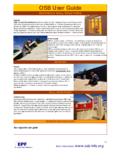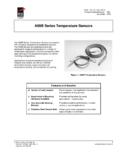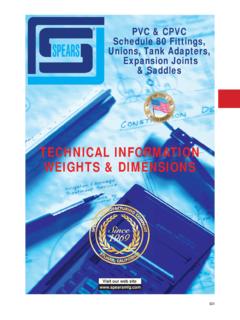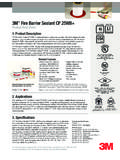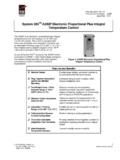Transcription of TECHNICAL INFORMATION SHEET - Oriented …
1 European Panel FederationEurop ischer HolzwerkstoffverbandF d ration Europ enne des Panneaux Base de Bois TECHNICAL INFORMATION SHEET OSB ( Oriented strand board) Description OSB ( Oriented Strand Board) is an engineered wood-based panel consisting of strands of wood which are bonded together with a synthetic resin; the strands are pressed together in layers. In the outer layers strands are generally Oriented longitudinally in line with the panel length, whereas in the middle layers strands generally lie in a cross wise direction. Composition The wood species used in OSB manufacture include both softwoods (spruce, pine) and some hardwood. Wood strands are cut tangentially from debarked logs which are held longitudinally against rotating knives. The ribbon of strands produced is usually about 75 mm wide and this breaks up on handling to produce individual strands which are typically 100 mm along the grain and from 5 to 50 mm across the grain.
2 After drying, these strands are sprayed with a synthetic resin binder. The resin types typically used include Phenol formaldehyde (PF), melamine fortified Urea Formaldehyde (MUF) or isocyanate (PMDI), all of which are moisture resistant binders. In Europe, it is common to use a combination of binders, typically PMDI would be used in the core and MUF in the face layers and this has the advantage of reducing press cycles whilst imparting a bright appearance to the surface of the panel. Appearance OSB is readily identified by its relatively large and long wood strands. The orientation of the surface strands is not always visually apparent, especially in small cut pieces of panel. The main merits of OSB lie in the field of its mechanical performance, which is directly related to the geometry of the strands and their orientation within the panel.
3 Although OSB is made up of relatively large strands of wood, its surface is relatively smooth and this can be further enhanced by sanding without loosing the aesthetic character which is unique to OSB. EPF - All e Hof ter Vleest 5 - Box 5 - B-1070 Brussels Phone : +32 2 556 25 89 - Fax : +32 2 556 25 94 - Bank : KBC Bank 426-8166011-44 - VAT : BE E-mail : - Internet: OSB varies in colour from a light straw colour to a medium brown depending on wood species used, resin system adopted and pressing conditions employed. It contains no knotholes, core voids or points of weakness. Density, mass and SHEET size Panel density (and thus panel mass) varies depending upon the product, being affected by the timber species and the manufacturing process. Typical densities are 600-680kg/m . Thus, for example, a 2400 x 1200 x 12mm panel will weigh approximately 20 kg.
4 Panel sizes commonly available are 2440mm x 1200mm, 2440mm x 1220mm and 2500mm x 1250mm in thicknesses of 6mm to 40mm. Other sizes are available or can be produced to order. Panels are produced with either square or tongued & grooved (T&G) edges. Applications Due to its high mechanical properties and the orientation of the strands within panels, OSB is particularly suitable for load-bearing applications in construction and is widely used for flooring, roof decking and wall sheathing, but there is also a wide field of other applications where OSB as a wood-based panel product can be utilised. Different grades of the product are available for different levels of loading and different environmental conditions. Guidance on the use of OSB in these load-bearing applications is given in ENV 12872 and EN 13986.
5 OSB is a quality, precision-engineered product that can satisfy the same applications and loading conditions as plywood and in some cases a thinner OSB panel may be used thereby reducing costs. Large quantities of OSB are also used for sarking and industrial packaging and in site hoardings and pallet tops. Specification It will soon be a legal requirement to demonstrate that OSB used in construction satisfies the requirements of the European Construction Products Directive. This legal requirement is written into national building regulations. Manufacturers shall demonstrate compliance with the legal requirements by showing that their OSB complies with the harmonised standard EN 13986 "Wood-based panels for use in construction - Characteristics, evaluation of conformity and marking". This standard should be published before the end of 2001.
6 It calls up EN 300 " Oriented Strand Boards (OSB) - Definitions, classification and specifications", which will have to be used when specifying OSB. Four grades of OSB are defined in EN 300 in terms of their mechanical performance and relative resistance to moisture. These are: OSB/1 - General purpose boards and boards for interior fitments (including furniture) for use in dry conditions. OSB/2 - Load-bearing boards for use in dry conditions. OSB/3 - Load-bearing boards for use in humid conditions OSB/4 - Heavy-duty load-bearing boards for use in humid conditions. 2 Mechanical properties The threshold value requirements for specified mechanical properties of the 4 OSB grades in EN 300 can be summarised as indicated in the following tables. The values are 95 percentiles (5 percentile values in the case of swelling in thickness) and are characterised by a moisture content in the material corresponding to a relative humidity of 65% and a temperature of 20 C.
7 This implies that these specified mechanical properties have to be controlled according to statistical principles and that 95% of the test values on individual samples have to exceed (or remain below in the case of swelling in thickness) the respective threshold value requirement in EN 300. Threshold value requirements for OSB/1 Requirement Test Unit Thickness range (mm, nominal) Property method 6 to 10 > 10 and < 18 18 to 25 Bending strength - major axis Bending strength - minor axis Modulus of elasticity in bending - major axis Modulus of elasticity in bending - minor axis Internal bond Swelling in thickness - 24 h EN 310 EN 310 EN 310 EN 310 EN 319 EN 317 N/mm N/mm N/mm N/mm N/mm % 20 10 2500 1200 25 18 9 2500 1200 25 16 8 2500 1200 25 Threshold value requirements for OSB/2 Requirement Property Test Unit Thickness range (mm, nominal)
8 Method 6 to 10 > 10 and < 18 18 to 25 Bending strength - major axis Bending strength - minor axis Modulus of elasticity in bending - major axis Modulus of elasticity in bending - minor axis Internal bond Swelling in thickness - 24 h EN 310 EN 310 EN 310 EN 310 EN 319 EN 317 N/mm N/mm N/mm N/mm N/mm % 22 11 3500 1400 20 20 10 3500 1400 20 18 9 3500 1400 20 3 Threshold value requirements for OSB/3 Requirement Test Unit Thickness range (mm, nominal) Property method 6 to 10 > 10 and < 18 18 to 25 Bending strength - major axis Bending strength - minor axis Modulus of elasticity in bending - major axis Modulus of elasticity in bending - minor axis Internal bond Swelling in thickness - 24 h EN 310 EN 310 EN 310 EN 310 EN 319 EN 317 N/mm N/mm N/mm N/mm N/mm % 22 11 3500 1400 15 20 10 3500 1400 15 18 9 3500 1400 15 Requirements for moisture resistance Bending strength after cyclic test - major axis OPTION 1 Internal bond after cyclic test OPTION 2 Internal bond after boil test EN 321 + EN 310 EN 321 + EN 319 EN 1087-1 + EN 319 N/mm N/mm N/mm 9 8 7 4 Threshold value requirements for OSB/4
9 Requirement Test Unit Thickness range (mm, nominal) Property method 6 to 10 > 10 and < 18 18 to 25 Bending strength - major axis Bending strength - minor axis Modulus of elasticity in bending - major axis Modulus of elasticity in bending - minor axis Internal bond Swelling in thickness - 24 h EN 310 EN 310 EN 310 EN 310 EN 319 EN 317 N/mm N/mm N/mm N/mm N/mm % 30 16 4800 1900 12 28 15 4800 1900 12 26 14 4800 1900 12 Requirements for moisture resistance Bending strength after cyclic test - major axis OPTION 1 Internal bond after cyclic test OPTION 2 Internal bond after boil test EN 321 + EN 310 EN 321 + EN 319 EN 1087-1 + EN 319 N/mm N/mm N/mm 15 14 13 5 Physical properties a)
10 Climate Like other wood-based panel products, OSB is hygroscopic and its dimensions change in response to a change in humidity. A 1% change in moisture content increases or decreases the length, width and thickness of the different grades of OSB by the amounts set out in the table below. Dimensional change for a 1% change in panel moisture content (ENV 12872) Type of panel Specification Dimensional change at 1% change in panel moisture content Length % Width % Thickness % EN 300, OSB/2 EN 300, OSB/3 OSB EN 300, OSB/4 As a guide, OSB can be expected to attain the following moisture content levels under the following specified conditions. Relative humidity at 20 C Approximate equilibrium moisture content 30% 5% 65% 10% 85% 15% OSB must be conditioned to bring it into equilibrium with its environment before it is fixed.
